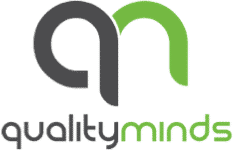At QualityMinds, we firmly believe that everyone has goals and wants to learn something. For almost four years now we have been helping with the learning goals of our employees and customers. Recently, we have also been talking more and more about teaching goals and the methods that can be used to achieve them. In the case of teaching goals, the origin is usually quite clear. For example, a teacher recognizes a deficit in her learners with regard to a desired level of knowledge. She then decides to close the recognized gaps in knowledge, for example by establishing the first basics for a topic, and thus defines a goal for the learners that they should achieve – e.g. acquire a certain skill. (How to recognize deficits in learners and how to deal with them is again very complex and certainly worth a separate blog article).
But where do personal learning goals actually come from?
The simplest answer is that a learner has set a goal and is trying to achieve it. But what is behind the choice of a personal learning goal? We have recently found four answers to this at QualityMinds:
- The learner wants to achieve an overarching goal and is motivated by the expected success.
- The learner wants to reduce a deficit or avert failure.
- There is increasing talk about a certain topic that the learner doesn’t know anything about; this topic area should be opened up.
- A teaching goal is adopted as a personal learning goal or overlaps with a learning goal.
Detailed description of these four points:
- Learners often choose a goal for which they previously lacked knowledge. For example, someone would like to try a new tool that he/she needs to be able to do the job faster or more purposefully, or a person would like to apply for a new position and needs to acquire additional skills for it. These goals focus on the achievement of personal goals. Similar to New Year’s goals, it is important to make sure that you cut the sub-goals small enough to make these goals measurable and to be able to celebrate regular successes.
- But sometimes learning goals are not only motivated by the desire to be able to or to achieve something new, but also by the desire to remedy a (perceived or actual) weakness, a deficit or to avert an impending failure. An example: a team has decided to work with a new programming language that the learner has not yet mastered. Now he/she wants to build up knowledge very quickly or refresh buried knowledge in order not to be left behind. Such a learning objective can also arise from negative feedback that the learner has received. For example, she/he wants to increase performance or develop a skill.
- Most of us know yet another reason: there is a new trend and during your coffee break you hear about unfamiliar things. Everyone seems to be enthusiastic about them and your own curiosity is quickly aroused when you hear words like: “Kubernetes”, “Agility”, “Working out Loud” or “Design thinking”. If you want to have a say on these topics, it makes sense to set a personal learning goal for building up ground knowledge and to familiarize yourself with basic content on this topic.
- Finally, another path that can often be observed: adopting teaching goals leads to creating learning goals. If, for example, an employee starts highly motivated in a new company and still wants to learn a lot about the working methods, the corporate culture or the content of his new job, his learning goals naturally overlap with the learning goals of the company or the team. If you analyze what prior knowledge is already available and what knowledge is still needed, these learning goals also create a wonderful learning experience.
Our conclusion:
Overall, it can be said that different people pursue different learning goals for different reasons. In any case, it is useful for the learner to reflect together with the learning coach on where their own learning goals actually come from. Why do I want to learn this? What do I actually want to achieve with it? How deep do I have to go to reach my goal? If you recognize where your own learning goals come from, you can also work specifically on the learning motivation, provide assistance in selecting the content or learning methods and generally better design the targeting of the learning process.


0 Comments